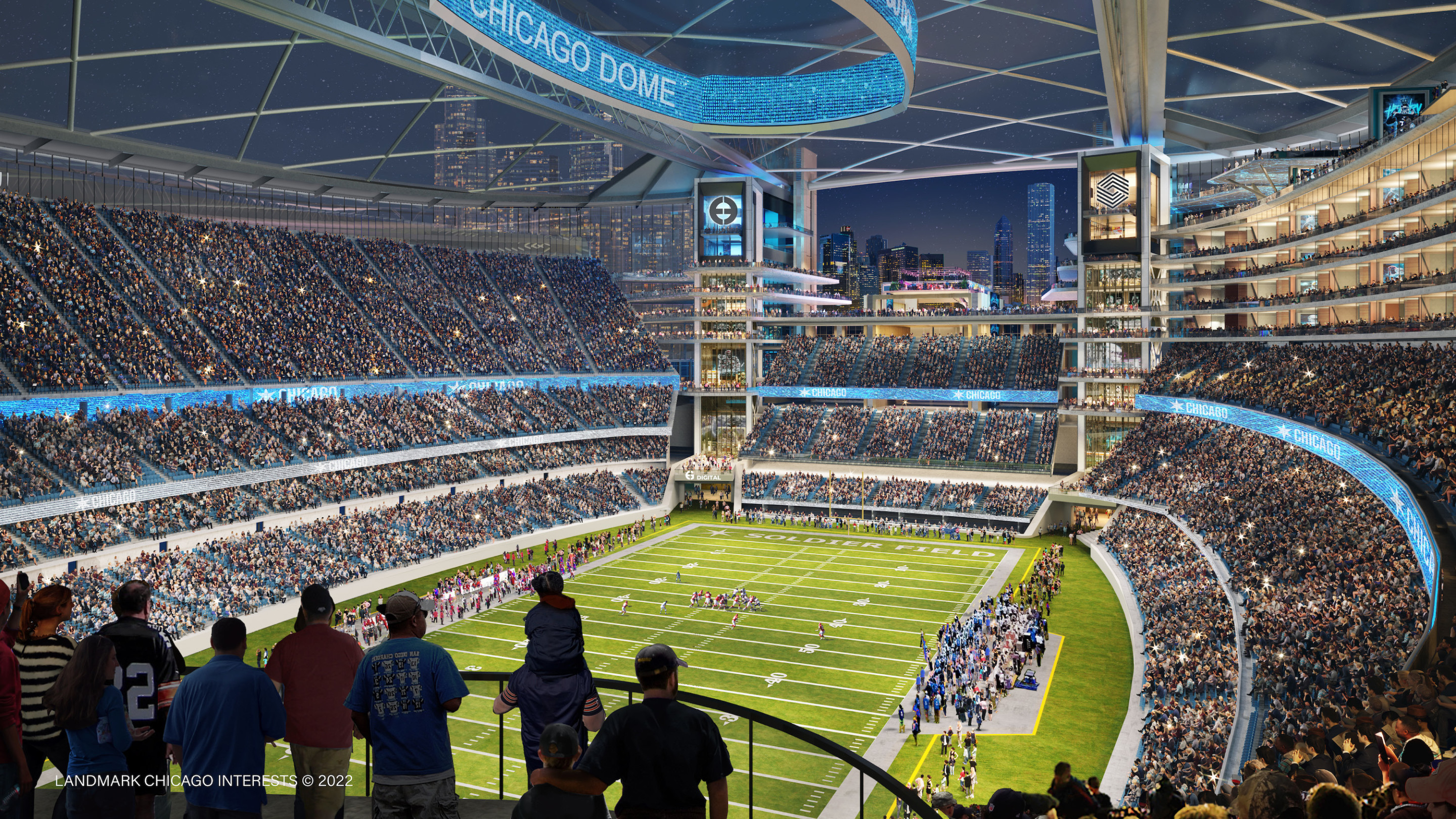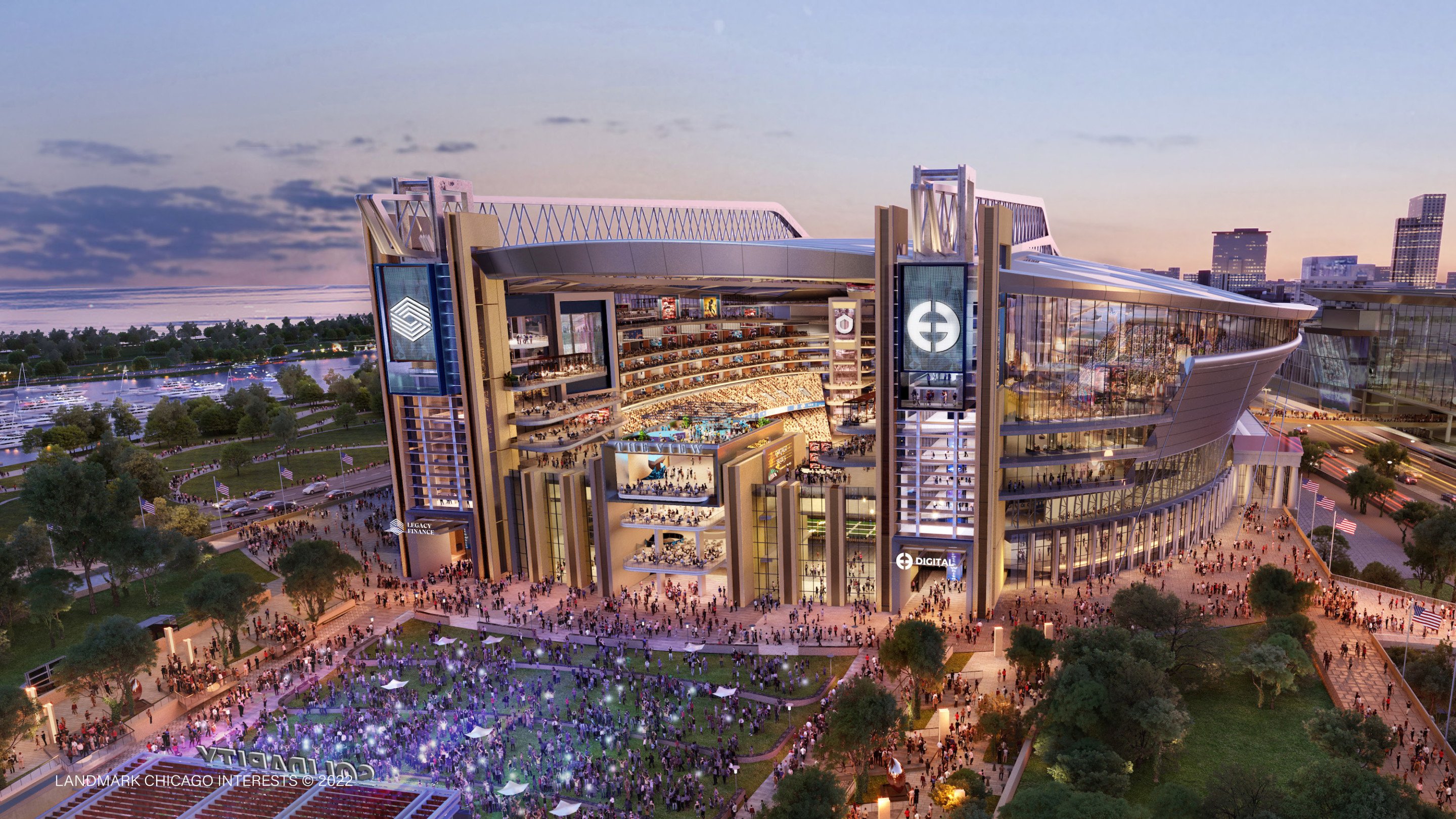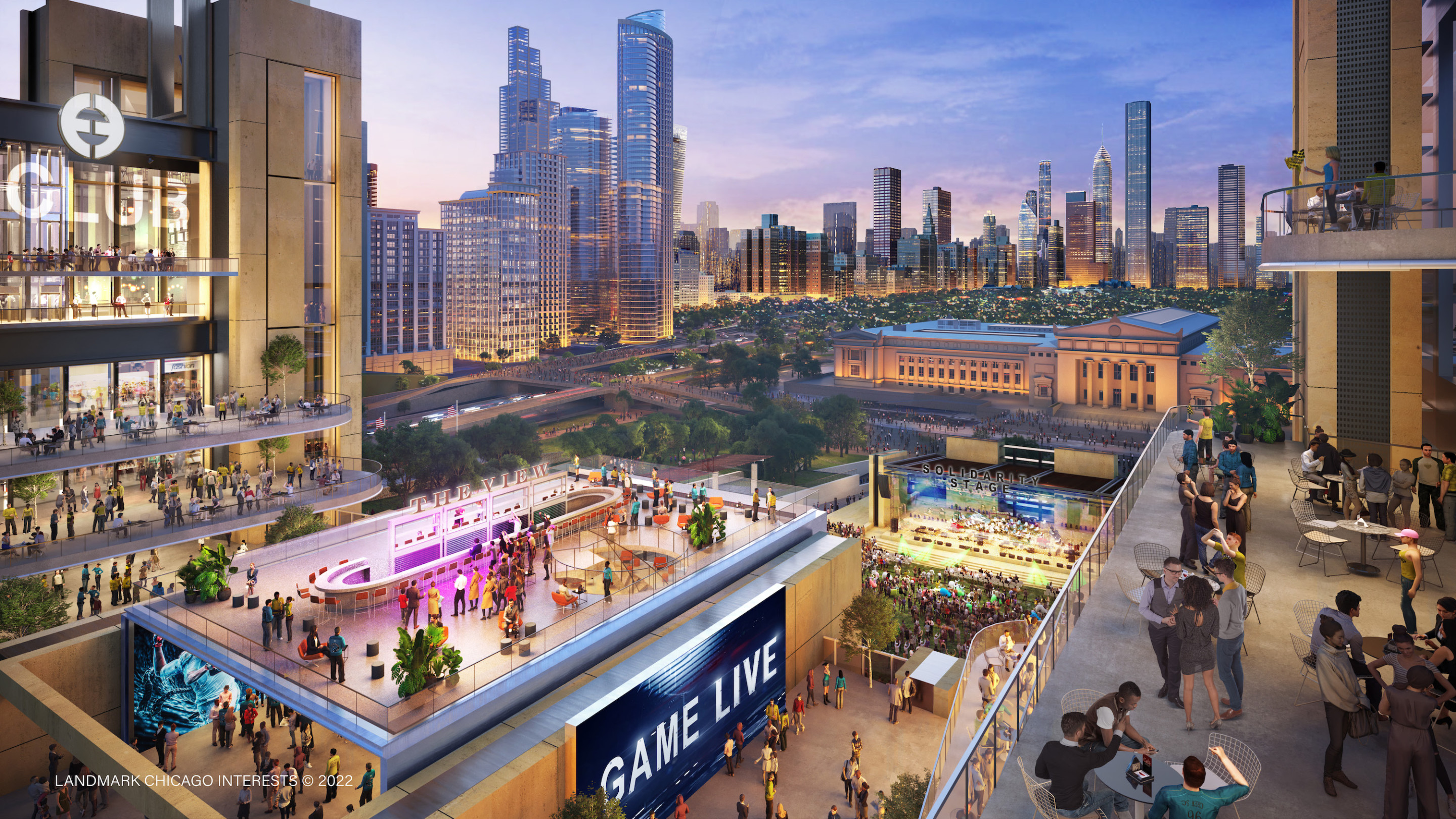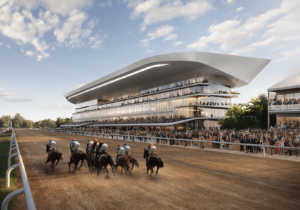This week Chicago Mayor Lori Lightfoot announced three major overhaul ideas for the city’s historic Solider Field, including two proposals that fully rebuild the NFL venue’s endzones to support a dome structure that would fully enclose the open-air stadium. A third proposal imagines an NFL-less future (more on that in a bit) by modifying the stadium to be “better suited” for soccer and other large-scale events like concerts.
All three proposals tie into an ambitious larger revamp envisioned for the Museum Campus, a 57-acre complex anchored by the nearly century-old Solider Field along with Shedd Aquarium, the Field Museum of Natural History, the Adler Planetarium, and the Lakeside Center at McCormick Place. Earlier this month, the Museum Campus Working Group published Where Worlds Connect, a comprehensive report detailing site-enhancing recommendations for the sprawling lakefront cultural and recreational zone.
Completed in 1924, Solider Field is the smallest stadium in the NFL with a capacity of 61,500, limiting Chicago from hosting major events like the Super Bowl. And although the Green Bay Packers’ Lambeau Field is the oldest purpose-built NFL stadium, Solider Field, home to the Chicago Bears since 1971, is the country’s oldest stadium overall currently used by an NFL franchise. Subject to a major interior renovation in the early aughts that further lowered its seating capacity (and caused the venue to be delisted as a National Historic Landmark), Solider Field has served as home turf for a slew of sports teams over its long history including current co-tenant the Chicago Fire of the MLS.

As mentioned, the just-unveiled renovations proposed for Solider Field play into the larger Museum Campus redevelopment scheme but with a specific purpose: enticing the Bears to abandon a planned move out the city to the northwestern suburbs where the team would build an entirely new stadium at the site of the old Arlington International Racecourse facility in Arlington Heights. (Curiously, the Bears first eyed Arlington Heights, roughly 30 miles outside of downtown Chicago, in 1971 before ultimately settling on Solider Field.) Team ownership signed a purchase agreement for the property in 2021 and the deal is anticipated to close by early next year.
The Bears’ lease at Solider Field runs through 2033 although the team could depart as soon as 2026 while incurring a major penalty.
A move by the Bears to the burbs would be, err, bad news for the city and many fans, thus the scramble to put forth a vision for an enlarged, enhanced, and enclosed Solider Field in hopes that the team will bite. (It’s widely viewed that they won’t but anything is possible at this point.) A lucrative naming rights arrangement for the stadium has also been floated by the city.

“Not surprisingly, we are doing what we believe is making a compelling case for the Chicago Bears to stay in Chicago,” said Lightfoot when unveiling the trio of proposals. “They want a tier one stadium environment to maximize revenues, and we agree that we are going to keep making the case to the Bears, the NFL and public that a revitalized Soldier Field makes the most economic sense for that storied franchise.”
Per Lightfoot, the Bears could save $1 billion by staying put at its longtime home in lieu of decamping to a new stadium development in Arlington Heights.
As reported by NBC 5 Chicago, Bears ownership, as of earlier this month, remains unwavering in its plans to move bid adieu to the Museum Campus and Solider Field and proceed with the acquisition of the 326-acre racetrack site in Arlington Heights.
As further detailed by Lightfoot in a press statement, any of the three proposed renovation options would “allow Soldier Field to retain its role as an economic engine for Chicago for years to come, as these changes will allow us to keep bringing sports, music and other exciting events to our city.”
As mentioned, the first two renovation options entail rebuilding the stadium’s endzones with columns to allow for a dome structure, with one of them rendering the venue “dome-ready” in the future. Both options, per the Mayor’s Office, “make Soldier Field a top tier NFL stadium with tremendous opportunity for the Bears to fulfill their vision.” All three proposals, including the third that forgoes the Bear-friendly dome idea to focuses on soccer-related improvements, including “major programmatic changes and concourse space improvements and, most importantly, preserve historical components of Soldier Field including the colonnades,” the Mayor’s Office elaborated.

The trio of renovation proposals were developed by the Bob Dunn-led Landmark Development along with a team of “stadium engineers, designers, and financial experts with deep NFL experience” who set out to create options that maximize the existing footprint of Soldier Field while also debunking “the previously-held assumption that Soldier Field cannot be domed,” according to the Mayor’s Office.
As detailed by the city, additional new measures to refresh and revive Solider Field include: expanding the current seating capacity from 61,500 to 70,000 (the Super Bowl minimum) including additional “fan activation areas;” increasing the number of suites from 133 to 140; introducing a half-dozen “club and experiential areas” that don’t exist at the stadium in its current form; increasing the available square footage of food- and beverage-dedicated areas from 50,000 square feet to a whopping 200,000 square feet; creating more flexible event space and multi-purpose venues at the site; and, as mentioned, “dramatically expanding” the potential for major sponsorships and naming rights.
That last element which would create revenue for the proposed renovations, is already not going over well with some prominent Chicagoans. Solider Field, unlike so many other major sports and entertainment venues, has never had a corporate moniker over its long and illustrious history. Aside from naming rights, Lightfoot has not publicly revealed any other potential revenue sources that would help to pay for the controversial proposed stadium renovations.
On that note, the realized proposals are anticipated to range in cost from $900 million to $2.2 billion although costs would be refined based on the finalized scope of each proposal; as noted by the city, these estimates are considerably less than the price tag of an entirely new stadium.











